During our latest trip to Japan, we also visited the southern island of Kyushu and we stayed 2 nights in Beppu, one of Japan’s most famous hot spring resorts.
Even though Beppu is a modern looking city, it offers an unmatched range of baths to be enjoyed, including ordinary hot water baths, mud baths, sand baths, and steam baths.
In addition, the Hells of Beppu are several spectacular hot springs for viewing rather than bathing. These places reminded me of New Zealand’s North Island.
SIGHTSEEING
Beppu has eight different springs: Beppu Onsen, Kannawa Onsen, Myoban Onsen, Kankaiji Onsen, Hamawaki Onsen, Kamegawa Onsen, Horita Onsen, and Shibaseki Onsen, each featuring public baths and ryokan with bathing facilities. Together they produce more hot spring water than any other onsen resort in Japan!
What makes Beppu different from other onsen resorts is the wide range of bath types that can be enjoyed here. Aside from conventional hot water baths, Beppu offers sand baths where bathers are buried in naturally heated sand, steam baths that are heated by the steam of a hot spring, and mud baths which are basically muddy hot water baths!
BEST BATHS
Tanayu
Tanayu is the main hot spring facility of the Suginoi Hotel, a leading ryokan in town. The massive complex offers elegant outdoor pools on the building’s roof with spectacular, unobstructed views over the city. Visitors can also use the mixed-gender Aqua Garden hot spring facility next door which is enjoyed in bathing suits.
Onsen Hoyo Land
This run down, yet atmospheric public bath complex is an onsen enthusiasts’ favourite and offers rare mud baths and steam baths in addition to conventional hot water baths. While the indoor baths are gender separated, the outdoor zone is partly mixed.
Takegawara
First constructed in 1879, Takegawara Spa is Beppu’s most famous bathhouse, offering sand and regular baths in an atmosphere of the past.
Beppu Beach Sand Bath
The second most famous place to enjoy sand baths in Beppu after the Takegawara Spa, the Beppu Beach Sand Bath offers sand baths along the coast of Beppu Bay.
HELLS – JIGOKU
The “hells” of Beppu are seven spectacular hot springs for viewing rather than bathing. Five of the hells are located in the Kannawa district and two in the more remote Shibaseki district. We only saw the Umi, Oniishibozu, and Shiraike Jigoku.

Kannawa District
Umi Jigoku
Probably the most beautiful hell, also known as the “sea hell” thanks to its blue water.


In its spacious gardens, there are a few smaller hells and a clear water pond with beautiful lotus flowers.

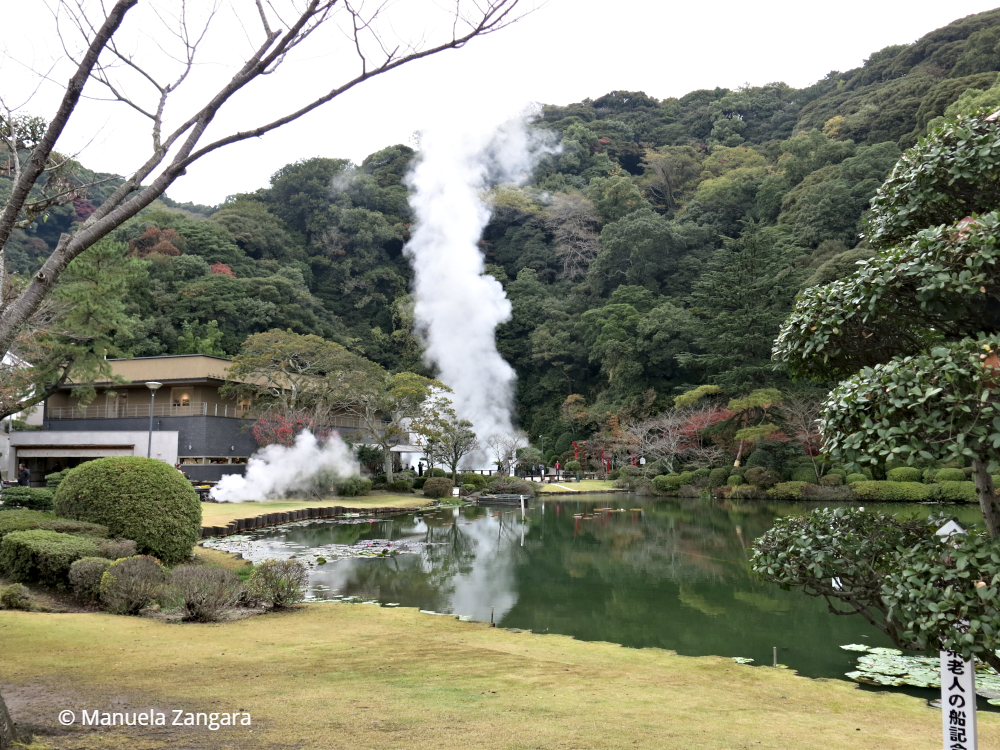

Oniishibozu Jigoku
This hell is named after the mud bubbles which emerge from boiling mud pools and look like the shaven heads of monks.




There is also a foot bath with clear water.

Shiraike Jigoku
True to its name, the “white pond hell” features a pond of hot, milky water.


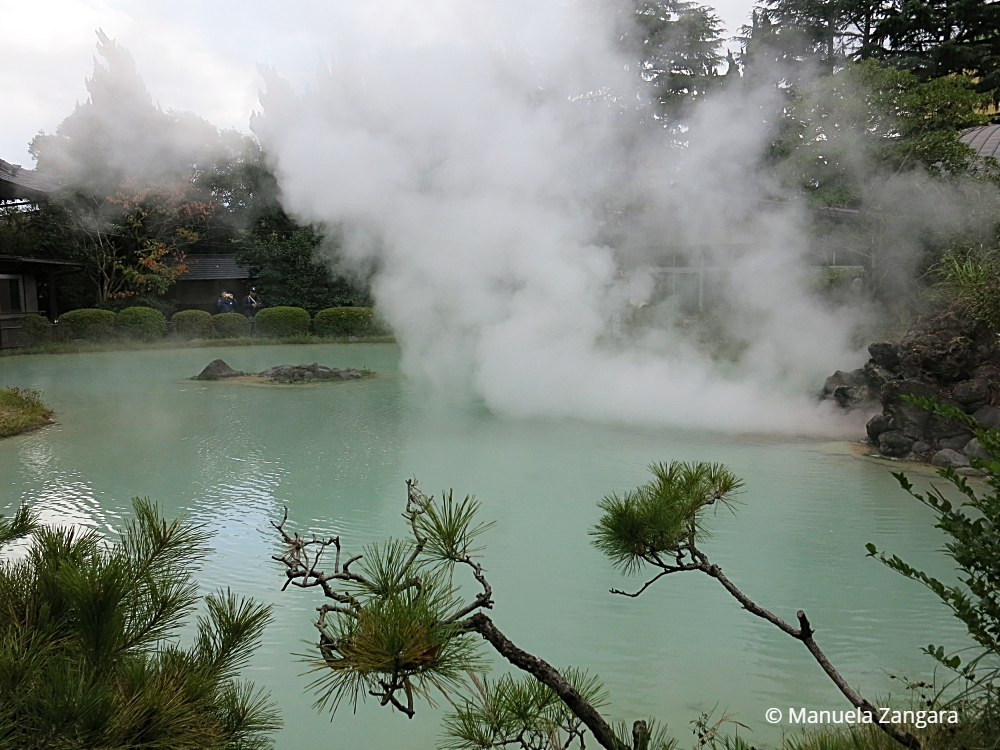
Kamado Jigoku
The “cooking pot hell” features several boiling ponds and a flashy demon statue as cook.
Oniyama Jigoku
A large number of crocodiles are bred and kept on the grounds of the “monster mountain hell”.
Shibaseki District
Chinoike Jigoku
The “blood pond hell” features a pond of hot, red water and a large souvenir shop. Apparently, it is one of the more photogenic hells.
Tatsumaki Jigoku
The “spout hell” features a boiling hot geyser, which erupts every 30-40 minutes for about 6-10 minutes.
FOOD
Beppu’s hot springs generate not only abundant amounts of water but also a lot of steam that can be seen blowing out here and there across the city. For centuries, people have been harnessing the naturally hot steam for cooking food. The resulting dishes are called “Hell Steam Cuisine”.
Tourists have the opportunity to steam their own meals at the Jigokumushi Kobo Steam Cooking Centre near the hells of the Kannawa District. Staffed by volunteers, the centre is a mix between a restaurant and public kitchen with rows of steam chambers that can be rented to cook food in.
Unfortunately we did not have time to try this, however, visitors can either bring their own food or purchase it and it sounds like fun!
ACCOMMODATION
RYOKAN
In Beppu, we stayed at Suginoi Hotel, a huge complex up on a hill overlooking the whole city/bay.

I did a lot of research before choosing this place. What mattered the most to me, in this case, was the quality of the onsen. Once realising that Suginoi Hotel had the best onsen in town, I decided to book a room there.
This place is completely different than any other hotel I had ever been at. Well… come to think of it, it did remind me a bit of a place in Las Vegas I went to a few years ago. It is THAT flashy!

First of all, it is divided into 3 buildings: Hon-Kan, Naka-Kan, and Hana-Kan, all with different room types, prices, and inclusions.
I decided to book a room in the Hana-Kan part as it included breakfast and dinner at the Ceada Palace, which seemed like fun (more about later). Besides, it is the closest building to the famous Tanayu onsen and the Aqua Garden. That said, it still took about 10 minutes to get there from our room! If you stay in the other buildings, you may have to walk from outside the hotel or take the shuttle bus.

While walking inside to hotel to get to the onsen area, you pass from a chapel (yes, they have weddings there as well!), a shop that sells all sorts of food/souvenirs…

… and a huge game arcade (bowling alley included!).

It’s like a small town!!
Tanayu is an open-air bath with great views over the city. It consists of a complex of tubs spreading out in five tiers like terraced rice paddies. It commands a magnificent and expansive views of Beppu Bay and the night view of the town.
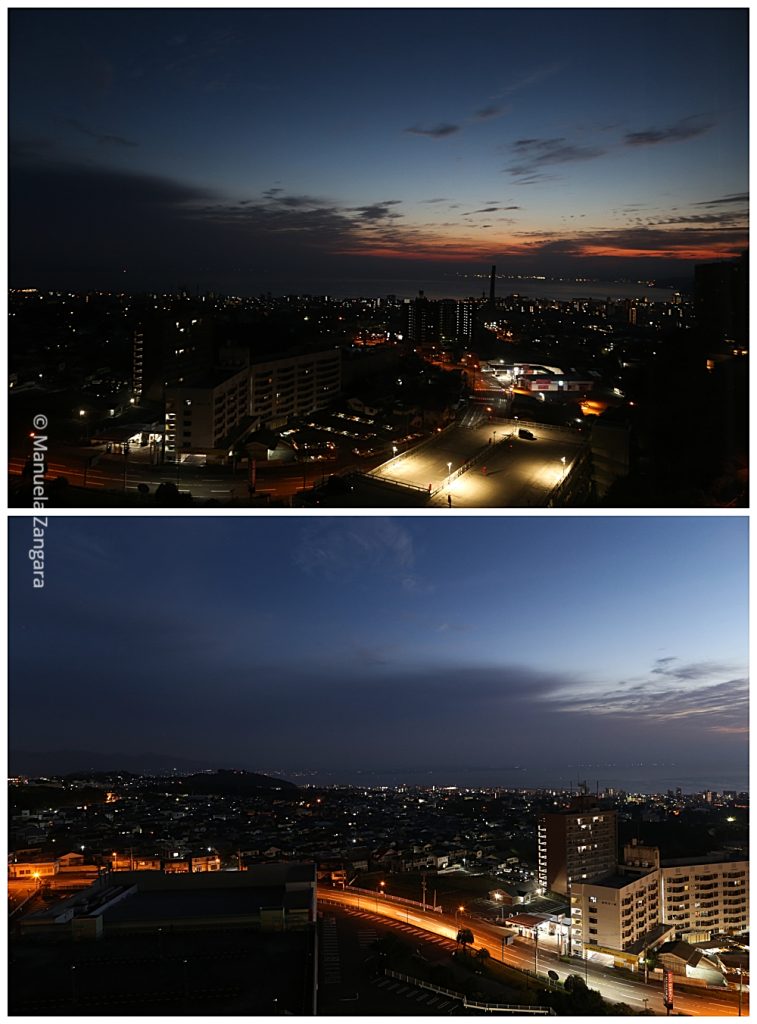
Tanayu also has various types of baths such as aroma bath, barrel bath, massage bath, observation sauna, and powder room.
It was packed (did I say the hotel is huge??), and although it wasn’t as relaxing and blissful as Kurokawa Onsen, it was still a nice experience.
Another great feature of Suginoi Hotel is the Aqua Garden. It’s basically a huge roof-top hot spring pool (you need to have a swimming suit to access it). Needless to say, the kids loved it. It is in the open-air, so it does get freezing cold at night. However, the water is hot, so it is quite pleasant.

At the Aqua Garden, there are also several illuminated musical “Fountain Shows” with 3-D images. So cool!! Especially if you get to see it from inside the pool!

Ah! They also had some amazing winter illuminations just outside the hotel.

So nice! The girls loved this too!

The hotel offers a complimentary shuttle bus to and from Beppu station, which is really convenient. Also, at the station check out the cute robot!!

The room itself was ok. It was spacious enough and it was half Western style and half Japanese style (with futon). I found the style to be a bit “old”. It reminded me of a room from the 80’s.

However, it had all we needed. Shower included.

And an amazing view over the bay!

We even had a Yukata each to wear for the night and to go to the onsen.
Booking was very easy. I booked through the hotel website.
DINNER AND BREAKFAST
As I mentioned before, we chose to eat at Suginoi Hotel. It is a bit “far” from the town centre and it was late November (cold!!) after all.
We chose a room plan that included breakfast and dinner at the Ceada Palace.

Both breakfast and dinner were buffet style, which at this point of the holiday, was a welcome change.
There was so much stuff. Both Western and Japanese.


I was absolutely blown away by their pizza. I don’t usually eat Italian food abroad, but I made an exception as it looked so good. Well, it was better than many pizza I have had in Italy itself! There, I have said it. Hats off. I complimented the chefs and they said they were trained in Italy. So, there you have it.

Desserts were another very strong point. Both beautiful to look and delicious to eat.




At dinner time, they also had a live band playing and singing!!

Breakfast was great too. There was everything you could think of: both sweet and savoury.


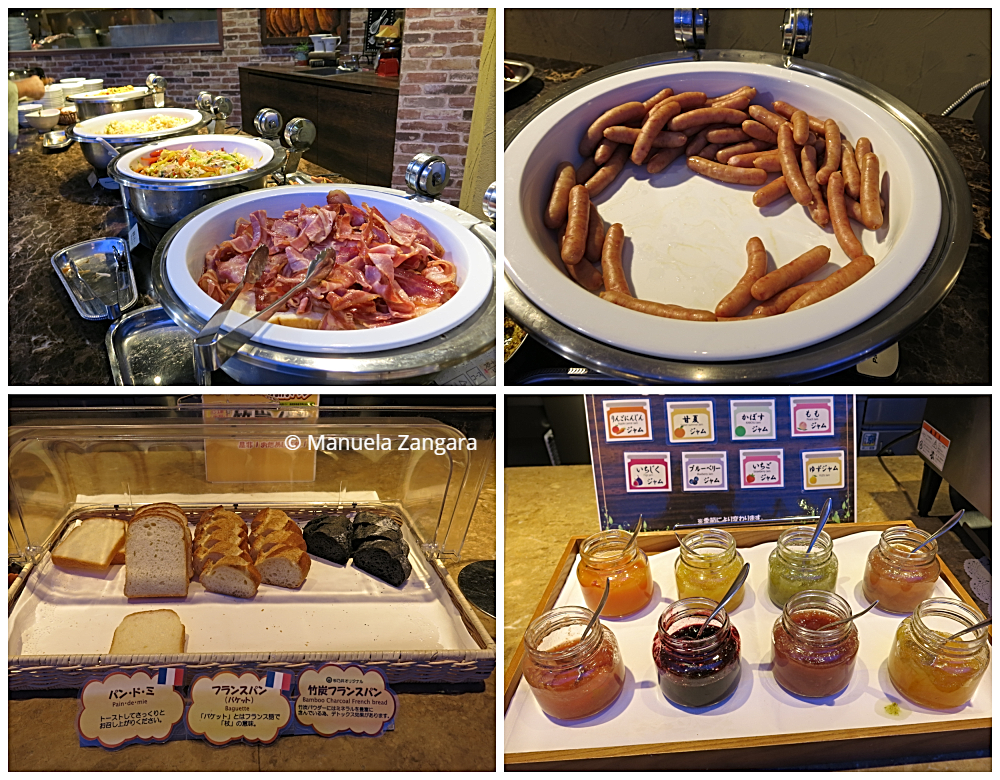
My kids loved this place so much, I think it was their favourite hotel in Japan over 3 trips! Just saying.
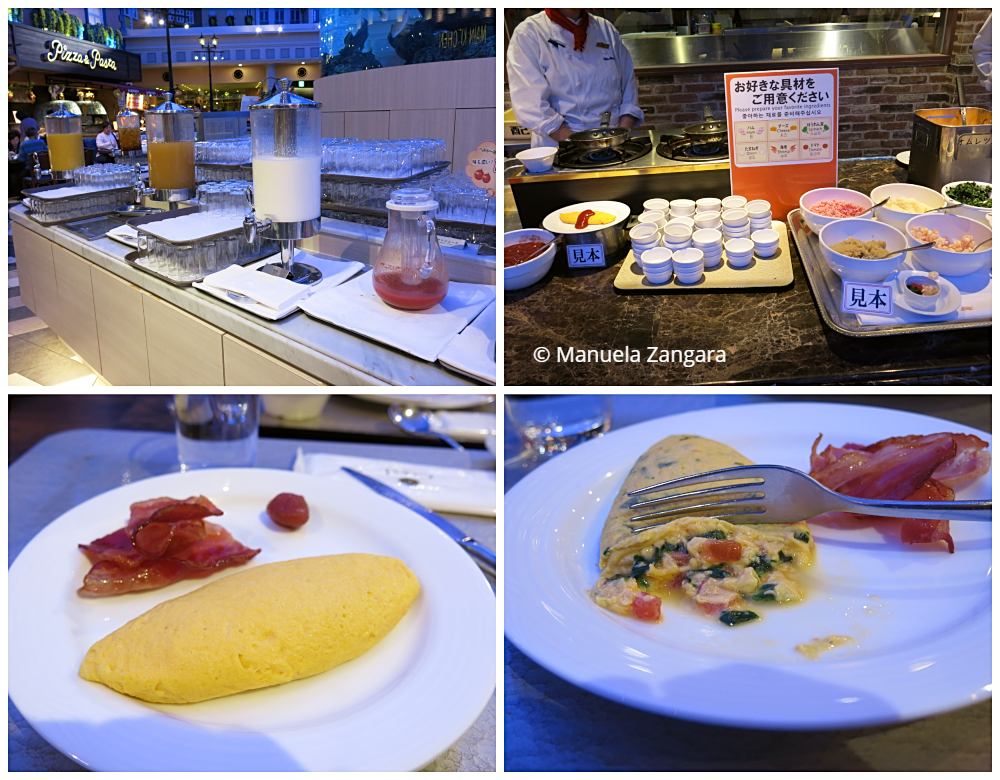

It was also one of the few places where we saw foreigners work. Apparently, there is a University in Beppu that has lots of exchange students from all over Asia and many of them work at this hotel. It was kind of good to be able to communicate a bit more in English.
I highly recommend Suginoi Hotel for a “different” experience. Even if you are not into big hotels (like me!), it’s a fun experience, especially if you like onsen and/or are travelling with kids.
We would definitely be back (ask my kids)!
HOW TO GET AROUND IN BEPPU
By bus!
The five hells in the Kannawa district can be easily accessed by frequently departing buses from JR Beppu Station in about 15 minutes. Bus number 5, 7 and 9 are the fastest. Get off at Kannawa bus terminal, from where all seven hells can be reached on foot.
Bus number 16/16A runs twice per hour from Kannawa to Shibaseki (5 minutes) where the remaining two hells are located. The bus then continues via Kamegawa Station to Beppu Station (40 minutes). Bus number 26/26A runs in the opposite direction of bus number 16/16A.
RESOURCES ON MSM
RECIPES:
TRAVEL IN JAPAN:
Nara & Fushimi Inari guide – Japan
Haru Cooking Class Kyoto – Japan Guide
Nagashima and Nabana no Sato – Japan Guide
Jigokudani Monkey Park Guide – Japan
Miyajima Autumn 2018 – Japan Guide
Don’t forget to pin this post!

HOW TO GET THERE FROM TOKYO

By train
Take the Tokaido/Sanyo Shinkansen from Tokyo (via Shin-Osaka) to Kokura Station and transfer to the Sonic limited express train for Beppu. The entire one-way trip takes about 6 or 7 hours.

By air
JAL, ANA, Solaseed and Jetstar Japan operate frequent flights between Tokyo (mostly Haneda Airport, except Jetstar which uses Narita Airport) and Oita Airport near Beppu. Flight duration is 90 minutes.
The one-way bus journey between Oita Airport and Beppu takes 40 minutes and costs 1500 yen. All buses stop at Beppu Kitahama, and a few buses also serve JR Beppu Station. Several rental car companies have an outlet at Oita Airport.







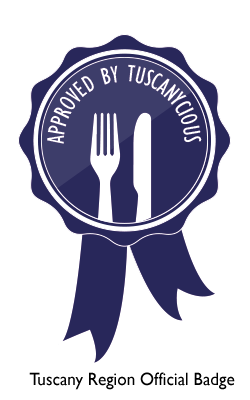












Leave a Reply